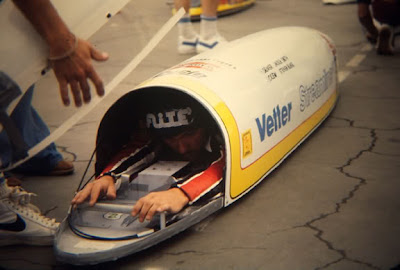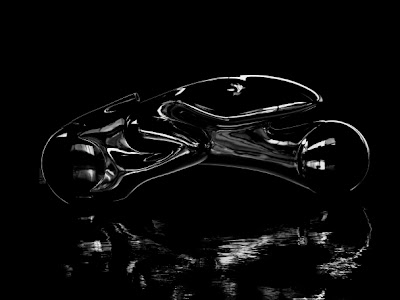Via: We heart it
Kamis, 16 Juni 2011
Rabu, 15 Juni 2011
Alfred Jarry ‘The Passion Considered as an Uphill Bicycle Race’
"Barabbas, slated to race, was scratched.
Pilate, the starter, pulling out his clepsydra or water clock, an operation which wet his hands unless he had merely spit on them — Pilate gave the send-off.
Jesus got away to a good start.
In those days, according to the excellent sports commentator St Mathew, it was customary to flagellate the sprinters at the start the way a coachman whips his horses. The whip both stimulates and gives a hygienic massage. Jesus, then, got off in good form, but he had a flat right away. A bed of thorns punctured the whole circumference of his front tyre.
Today in the shop windows of bicycle dealers you see a reproduction of this veritable crown of thorns as an ad for puncture-proof tyres. But Jesus’s was an ordinary single-tube racing tyre.
The two thieves, obviously in cahoots and therefore ‘thick as thieves’, took the lead.
It is not true that there were any nails. The three objects usually shown in the ads belong to a rapid-change tyre tool called the ‘Jiffy’.
We had better begin by telling about the spills; but before that the machine itself must be described.
The bicycle frame in use today is of relatively recent invention. It appeared around 1890. Previous to that time the body of the machine was constructed of two tubes soldered together at right angles. It was generally called the right-angle or cross bicycle. Jesus, after his puncture, climbed the slope on foot, carrying on his shoulder the bike frame, or, if you will, the cross.
Contemporary engravings reproduce this scene from photographs. But it appears that the sport of cycling, as a result of the well-known accident which put a grievous end to the Passion race and which was brought up to date almost on its anniversary by the similar accident of Count Zborowski on the Turbie slope — the sport of cycling was for a time prohibited by state ordinance. That explains why the illustrated magazines, in reproducing this celebrated scene, show bicycles of a rather imaginary design. They confuse the machine’s cross frame with that other cross, the straight handlebar. They represent Jesus with his hands spread on the handlebars, and it is worth mentioning in this connection that Jesus rode lying flat on his back in order to reduce his air resistance.
Note also that the frame or cross was made of wood, just as wheels are to this day.
A few people have insinuated falsely that Jesus’s machine was a draisienne, an unlikely mount for a hill-climbing contest. According to the old cyclophile hagiographers, St. Briget, St. Gregory of Tours, and St. Irene, the cross was equipped with a device which they name suppendaneum. There is no need to be a great scholar to translate this as ‘pedal’.
Lipsius, Justinian, Bosius, and Erycius Puteanus describe another accessory which one still finds, according to Cornelius Curtius in 1643, on Japanese crosses; a protuberance of leather or wood on the shaft which the rider sits astride — manifestly the seat or saddle.
This general description, furthermore, suits the definition of a bicycle current among the Chinese: “A little mule which is led by the ears and urged along by showering it with kicks.”
We shall abridge the story of the race itself, for it has been narrated in detail by specialized works and illustrated by sculpture and painting visible in monuments built to house such art.
There are fourteen turns in the difficult Golgotha course. Jesus took his first spill at the third turn. His mother, who was in the stands, became alarmed.
His excellent trainer, Simon the Cyrenian, who but for the thorn accident would have been riding out in front to cut the wind, carried the machine.
Jesus, though carrying nothing, perspired heavily. It is not certain whether a female spectator wiped his brown, but we know that Veronica, a girl reporter, got a good shot of him with her Kodak.
The second spill came at the seventh turn on some slippery pavement. Jesus went down for the third time at the eleventh turn, skidding on a rail.
The Israelite deminondaines waved their handkerchiefs at the eighth.
The deplorable accident familiar to us all took place at the twelfth turn. Jesus was in a dead heat at the time with the thieves. We know that he continued the race airborne — but that is another story."
Via: MKF Via: I Often Dream of Trains
The Militaire Autocycle Company (later to be Militors in the example we see above), was founded in Cleveland, Ohio in 1911. The bike, featured wooden artillery wheels, two girder-type frame rails (like an automobile), hub-center steering, and a 11 horse power inline four cylinder engine connected to standard floor shift trans( complete with reverse) and was actually conceived as a two-wheeled automobile complete with retractable training wheels to make it stable at rest, since its operator was not required to put their feet down. The length of bike at 97" made it the longest bike of it era. Very few Militaires/Militors are known to exist today. A pity.
Pict via: Jack Snell's photostream
Selasa, 14 Juni 2011
Via: Visible Innards
Michael Sewert, Snow Crash book cover illustration.Via: Rude Mechanicals
Senin, 13 Juni 2011
Langganan:
Komentar (Atom)

















































